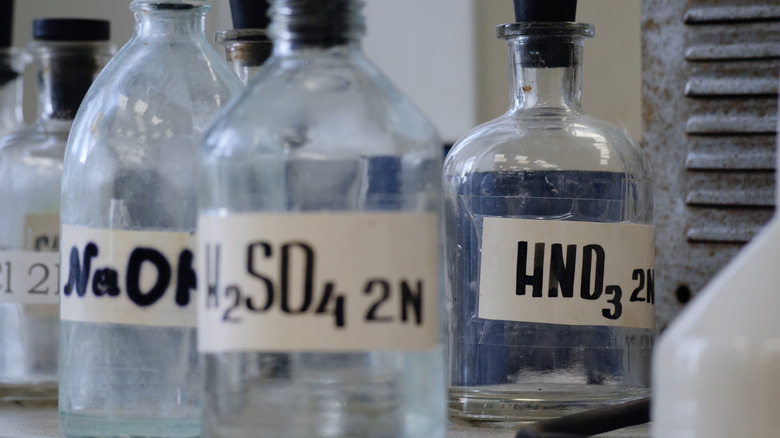What Is The Formula For Sulfurous Acid?
Chemical formulas tell you the constituent atoms of any molecule, and provided you understand how they work, you can easily find the formula for any chemical. Sulfurous acid has never been observed to exist in a liquid solution, but has been found as a gas. Many people confuse it with sulfuric acid, but it is actually a distinct chemical with a different formula. It has the chemical formula H2SO3.
TL;DR (Too Long; Didn't Read)
The chemical formula of sulfurous acid is H2SO3, and it has a formula mass of 82.
The Formula for Sulfurous Acid
The Formula for
Sulfurous Acid
A chemical formula lists the individual elements in each molecule and how many of each makes it up. They use the standard symbols for the elements and include a subscript that indicates the number of atoms of each in the final molecule. For example, H2O is water, composed of one atom of oxygen (O) and two atoms of hydrogen (H).
Sulfurous acid has the formula H2SO3. This means it contains two atoms of hydrogen (H), one atom of sulfur (S) and three atoms of oxygen (O). The structure of the molecule has the sulfur atom in the middle, with the three oxygen atoms bonded to it, two of which are single-bonded and one of which is double-bonded. The two hydrogen atoms attach to the single-bonded oxygen atoms.
The Formula Mass of Sulfurous Acid
The Formula Mass of Sulfurous
Acid
Formula mass is a measure of the total relative atomic mass for a whole molecule. Although the constituent parts of atoms (protons, neutrons and electrons) each have very specific masses in kg (protons and neutrons on the order of 10−27 kg and electrons much smaller at close to 10−30 kg), the numbers are so small chemists use a different method for describing them. Electrons are much lighter than protons and neutrons, so their masses are simply ignored. The mass of a proton or a neutron is set at 1 on the relative atomic mass scale. This means hydrogen, with one proton and one electron, has a relative atomic mass of 1.
Find the relative formula mass of any compound by adding up the relative atomic masses of the constituent elements. Use a periodic table to find the relative atomic mass of any element. Calculate the total mass of the molecule on the basis of this and the chemical formula. For sulfurous acid, there are two atoms of hydrogen (relative atomic mass = 1), one of sulfur (relative atomic mass = 32) and three of oxygen (relative atomic mass = 16), so in total:
Formula mass = (2 × 1) + (1 × 32) + (3 × 16) = 82
So the formula mass of sulfurous acid is 82.
Note that the periodic table lists more precise relative atomic masses, but this is only to account for different isotopes of the elements sometimes found nature. In many situations, you can simply round these figures to the nearest integer.
Cite This Article
MLA
Johnson, Lee. "What Is The Formula For Sulfurous Acid?" sciencing.com, https://www.sciencing.com/what-is-the-formula-for-sulfurous-acid-13710215/. 27 March 2018.
APA
Johnson, Lee. (2018, March 27). What Is The Formula For Sulfurous Acid?. sciencing.com. Retrieved from https://www.sciencing.com/what-is-the-formula-for-sulfurous-acid-13710215/
Chicago
Johnson, Lee. What Is The Formula For Sulfurous Acid? last modified March 24, 2022. https://www.sciencing.com/what-is-the-formula-for-sulfurous-acid-13710215/
